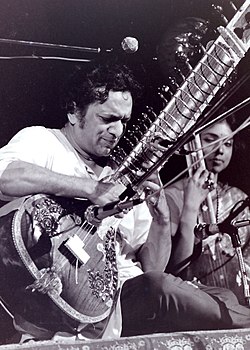Indian classical music refers to two distinct yet related musical traditions in South Asia: Hindustani classical music in the north and Carnatic classical music in the south.
Understand
[edit]
The origins of Indian classical music go far into times B.C., and basic concepts of scale and interval have remained essentially constant in Indian classical music for over 2,000 years. There are also basic forms such as the raga (Hindustani) and kriti (both styles, but especially Carnatic) which are long-established. However, Indian classical music includes a great deal of improvisation, so if you hear two different performances of a specific piece, they may be of very different lengths, have more or less ornamentation, and be played in very different instrumental combinations, with or without singers. Yet listeners who know the style will recognize them as the same song. While there are minor regional variations, Indian classical music was overall an integrated system until around the 13th-14th centuries A.D., when political upheavals led to isolation between the north and south. Gradually the classical musical tradition diverged into Hindustani and Carnatic. However, both traditions have continued to influence each other over the centuries, and particularly in modern times. There has also been some influence from Western music, particularly inasmuch as some instruments brought to South Asia during the British Raj have been integrated, especially the violin, and also the saxophone beginning in the 20th century. Pakistan and Bangladesh are part of the Hindustani tradition in classical Indian music. Traditionally, all or nearly all pieces of Indian classical music can be sung with words and are religious (usually Hindu or Muslim, but some are Christian or of other religions) and in some measure, praise to a deity.
Indian classical music gained exposure and rose to prominence in the West and the rest of the world in the 1960s with the rise of the hippie movement and rock musicians such as the Beatles and Mike Love from the Beach Boys travelling to India and being influenced by Indian sounds. This fusion genre incorporating the use of the sitar, drones and other features became known as raga rock and peaked in popularity during the late 60s. The most famous Indian classical musician at the time, sitarist Ravi Shankar, became a household name abroad.
Instruments
[edit]Indian classical music has essentially three kinds of instruments:
- A drone, usually provided by repeated notes on a plucked string instrument, the tambura, or electronically from a sruti box, which sounds almost the same. The notes are typically 5-octave-octave-1, in terms of the notes of the rag (mode).
- A drum or set of drums that keeps time. In the Hindustani tradition, the core of this section is provided by the tabla player, who plays a pair of drums, one of which is pitched. In the Carnatic tradition, the core of this section is the mrdangam, a double-headed drum with one pitched head.
- The melody instruments. There can be one or more. Vocalists are in this category, which also includes plucked string instruments such as the sitar, vina and sarod, bowed strings such as the sarangi and violin, and the bansuri wooden flute, though there are many others.
Sound and feel
[edit]Each piece of classical Indian music is in a specific rag - that is, a mode with specific pitches, intervals and melodic tendencies. Each rag is also associated with a particular emotion, deity and time of day, so in long concerts, there can be a progression from one rag to another as the day moves into a different period.
Each piece is also in a particular tala. Tala is meter, the repeating framework which is the foundation for all the rhythms in metered sections. Talas in Indian music are typically more complex and in longer cycles than in most European music. It is common for pieces to begin unmetered, with one or two completely improvised sections. Generally, the tala begins when you start to hear a steady rhythm from the tabla or mrdangam player.
Indian music theory has the concept of a pitch, called a svara, but there is generally a high to very high level of ornamentation in Indian music, so a single note is often not one steady pitch. A greater difference from much European music is that intervals between notes in Indian music are rarely close to the 12-tone even tempered system that has been ascendant in most European music for over 100 years. Instead, each rag has its own intervals, and everyone tunes their instrument for each rag before the composed melody of the piece is sounded. In the case of plucked string instruments, this means moving the frets so that they sound only the tones of the particular rag before being performed.
Talk
[edit]Destinations
[edit]- 1 Maihar. The birthplace of the Maihar gharana, a sitar-based school of Hindustani classical music. Doyen Ustad Allauddin Khan and his prominent disciples Ravi Shankar and Nikhil Banerjee lived in Maihar for a long time.



Events
[edit]- Chennai December Season: Chennai. Annual cultural event spanning 9 weeks from mid-November to January. Many of the greatest professional and amateur Carnatic musicians perform all kinds of compositions and improvisations in halls owned by the sabhas (Carnatic music organisations that run the event). The performances typically take place in the afternoon and evenings. (date needs fixing)
- Dhrupad Mela: Varanasi. A 4-day Hindustani music extravaganza in February. Artists perform throughout the night, enlivening the Tulsi Ghat in the Hindu holy city. The festival culminates at sunrise. (date needs fixing)
